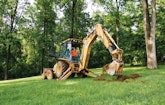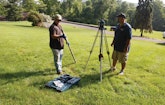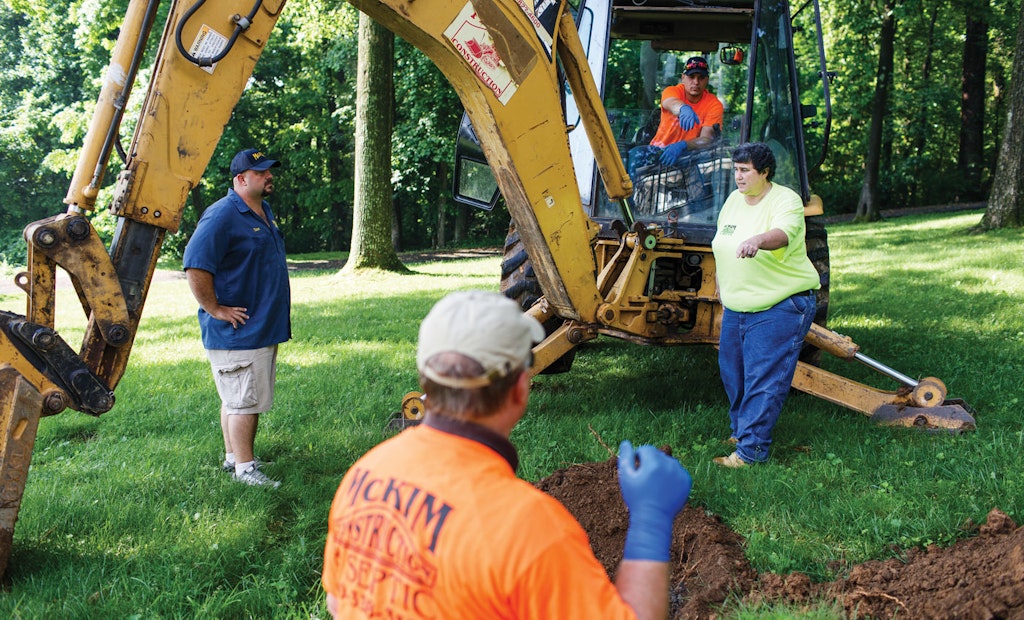Interested in Trucks?
Get Trucks articles, news and videos right in your inbox! Sign up now.
Trucks + Get AlertsThe area around Washington, D.C., is busy, and in this thriving corner of northeastern Virginia, the McKim family has built a thriving onsite business. McKim Septic in Purcellville is a truly full-service wastewater company. Its technicians install private wastewater systems for single homes or entire subdivisions, and then maintain or fix them if they’re mistreated.
With all of the population and commercial growth near the nation’s capital, and with people moving in and out all the time, there is an expanding future for onsite installers and maintainers. At the same time, the leaders at McKim are trying to not grow. Yes, not grow, because growth brings costs that have nothing to do with investing in equipment and workers, and that can be detrimental to keeping the business thriving.
Finding people who do work the way the McKims want it done is hard. “Could we grow and do more? Yes, but we’re trying not to because we do not want to trade quality for more work,” says Walt McKim. At 81, he is the third generation of his family in the construction business and co-owns the company with his wife, Lorraine.
McKim Septic has two main divisions. One is for installation, one for service. The installation side is run by son Steve. Services — pumping, replacing failed drainfields, inspecting and maintaining systems — are overseen by daughter Michelle. (There is another arm to the family enterprise, too, an excavating division run by son Mike.)
REGULATIONS ENSURE BUSINESS
What makes the company work is its diversity. The onsite divisions generate 40 to 45 percent of the overall company income, and revenue from installation and service is about evenly split.
“But the service side has a habit of growing, so I think (Michelle) will outrun Steve eventually,” Walt says. “Septic fields are always going to be here, there’s always a market for repairs, and people don’t like to do the dirty work. They would much rather install systems because everything is clean, so the competition is tougher for Steve.”
Loudoun County, where Purcellville is located, has about 20,000 septic systems, and every year the county mails postcards to 5,000 owners requiring them to pump their systems. After five years, every system has been pumped, and the cycle begins again. Most Virginia counties are adopting similar rules, and as a result the market for pumping has become large and competition has increased. But it’s still the dirty end of the business where competition is less fierce, Walt says.
With the growth, particularly on the maintenance side, it might seem logical that McKim would be adding to its busy fleet of vacuum trucks that play an important role in providing a full service to customers. But the decision to buy equipment isn’t that easy, Walt says.
“People who will do the pumping right — the way we want — they’re hard to find. And some of our competitors have lost their licenses because they cut corners, and the county found out,” he says.
“But our business keeps growing. Our name is good, especially when customers find out Lorraine and I are still operating out of the office. We get letters and calls from our customers who tell us our crews and children treat them with such respect that they’ll be our customers for life,” Walt says.
QUALITY ASSURANCE
It’s one thing when an owner-operator does a job. The quality is there because the owner cares. When you’re running a division with a couple dozen technicians, the key is transferring your standards to them.
“It’s repetitive training,” Steve says. “We hold in-house classes with our technicians for pumping and installing. We teach them about new ordinances, new products and new techniques. Our distributor does training, too, and we send our people there to learn.”
Indoor training for installation crews happens a couple of times a year on a rainy day or a day when the schedule is light. Everyone gathers in the shop, and they’ll talk for an hour or two first thing in the morning or at the end of the day. Technicians may have questions or may have a different technique they want to share with others. Most training for installer technicians takes place out in the field so they can see how to do something. On the service side, training happens every four to six weeks.
“Most of what we do is subdivisions, but we do install for small builders and individual systems along with some light commercial,” Steve says.
Most of the subdivision work is individual systems, but they have done some community systems that collect wastewater from a group of homes and send it to a private treatment plant serving all the homes. There will always be more individual subdivision lots to work on, but community systems have become increasingly popular during the past five years, Steve says. Developers are starting to realize a central plant is more economical is some situations. The largest community system in the company’s portfolio was 68 homes. Other subdivision jobs, with one system per home, have ranged up to 150 homes.
Conventional septic systems are still common, but Steve says the number of ATUs will also increase in the future. New state and local regulations are driving this, in particular the rules to protect the waters of Chesapeake Bay. What is used in any given installation is, of course, up the engineer, but in this part of Virginia, Microfast units from Bio-Microbics and EcoPod systems from Delta Environmental are most common.
The work keeps three installation crews busy every day.
FAMILY IN THE BUILDING TRADES
The onsite work follows a rich family history working construction.
“My grandfather built beautiful homes in Pittsburgh during the 1930s — old brick and stone with steel casement windows. In the attic were oak floors that my father stained and finished,” Walt says. Building was not for Walt — at least not at first. For a decade he worked at the Central Intelligence Agency. He met Lorraine there and they fell in love.
“And after 10 years of shaving and putting on a tie every day, I came to my wife and said ‘I would like to build houses like my grandfather and my father did,’ and like Ruth and Naomi in the Bible, she said wherever I go, she’ll go,” Walt says.
As they had the first of eight children, (seven of whom are still living) they broke into the building business. Over the past 30 years, the company developed its specialty in excavation and onsite work. The McKims made the change from above-ground construction to counter the boom-and-bust cycles of the building business.
“We lost out in the ’70s, and then we started again in the ’80s. We got stuck when interest went to 21 percent — and nobody was buying houses at 21 percent when carpenters were making $6 and $7 an hour. So then we got into full-time excavation and septics and repairs, and that’s where we stayed. In the meantime, we’ve seen a lot of companies in the homebuilding business come and go,” he says.
When their children became involved and decided to stay with the business, they expanded to excavating for large builders constructing hundreds of homes a year in northern Virginia and West Virginia.
The company’s excellent reputation attracts that business and keeps it, Walt says. And no small part of that is thanks to his children, he says.
Before coming to work for her parents, Michelle, the McKim’s oldest child, started her own dump truck business. The economy knocked that out from under her, but she knew that semis run all the time. With her parents’ help she bought a truck with a sleeper cab, found a broker to get her work, and went on the road for six years. She left every Monday, came home on Friday, and in between ranged across the eastern U.S., as far north as Vermont, south to Key West, Florida, and as far west as Texas.
“There are days I miss it. I enjoyed driving, but I enjoy working for my parents. But I haven’t listened to a radio since I came to work. In the truck the first thing I did in the morning was turn on the radio, and the last thing I did at night was turn it off,” she says.
Steve is the youngest.
“I always worked for Dad. I had a couple of jobs after high school, but I also worked for him,” he says.
EQUIPMENT UP TO THE TASK
A diverse company needs a large selection of equipment. McKim maintains:
- Eight loaders, a mix of Cat 953s and 963s
- Four Cat backhoes, two 416s and two 420s
- Four Cat D3 bulldozers
- Two Cat mini-excavators, one 303 and one 303.5
- Eight Takeuchi skid-steers, six TL130s and two TL230s
- A Cat 320 trackhoe
- Two 2009 Kenworth vacuum trucks with 3,800-gallon aluminum tanks
- A 1998 Freightliner vacuum truck with a 3,000-gallon steel tank and a Presvac PV750 system
Dump trucks are equipped with Reading boxes, and two lowboy trailers were built by Talbert Manufacturing Inc. Service trucks are from Ford or Chevy.
Most of the equipment, especially the big stuff, goes with son Mike for the excavation division. To the installation and service side go four Takeuchi skid-steers, four backhoes, two mini-excavators, usually a loader, and a trackhoe. But if there is a need for the big equipment, for example to clear trees from a site, Mike is a phone call away.
Three full-time mechanics keep all the equipment running. They work six days a week. They can’t rebore a head for new pistons — that work goes to the Cat dealer — but they fix everything else down to the chainsaws, says Michelle, who oversees the shop.
PEOPLE POWER
Recruiting and retaining mechanics and others on the staff can be difficult. In part it’s the competitive labor market around the capital city. It’s also looking out for the quality of work.
“We’re pretty careful about whom we hire. We’re always short, but that happens because of turnover. On any given day there are two to four people not at work for various reasons,” Walt says.
The company pays full benefits: health insurance, dental and vacation that accrues at one day for every two months of work. Walt says they like to run lean. When people are absent, co-workers earn overtime, and that provides incentive to stay, he says. Also, the company does not risk the inefficiency of having someone idle, which can happen if there are too many people and a lull in work.
“We have a lot of companies head-hunting our employees because they’re pretty good. Fortunately, most of our people stay because they know we have a pretty good company,” Michelle says.
Employees are split between divisions. About 20 employees work for the excavation division, and the other 20 work in installation and service.
Part of taking care of their crew is safety. “We stress that every day with our crew,” Walt says.
Every once in a while, Walt says, he will see something wrong while driving around and checking on crews. It may be a machine parked facing downhill. It may be a bucket left in the air when a machine isn’t running.
“We have a meeting on the spot to remind the technician of proper practices so he doesn’t forget it the next time,” Walt says.
KEEP ‘EM HAPPY
But it’s the customers who are key to the McKims’ success, and they don’t skimp on service.
Whenever they install a drainfield, they review the procedure with the customer, Steve says. Customers learn what they have, where all components are located, and what they should and should not put down their drains.
It’s just another part of the company’s culture of service and a desire to make sure its customers can have their wastewater needs met, whether those needs are a full system or simple maintenance.
Walt McKim may not want the family company to grow much more, but with its long history and the wide range of services it offers, McKim’s customers would probably have a different answer.
Rules of the road
Safe driving is something the management at McKim Septic is always emphasizing with the work crews.
“Although our drivers are young, they’re pretty good. But we still have accidents. We stress a following distance of four seconds behind the vehicle ahead even at a speed of 35 miles an hour,” says company owner Walt McKim.
You may remember a different rule from driver’s education: a two-second following distance.
“We settled on a four-second distance ourselves,” Walt says. “Let me hit my brakes when you’re two seconds behind me, and you’re going to have a hole in your radiator from the tow bar on the back of my truck.”
In a commercial vehicle, and when towing machines, vehicle weight is much heavier than the average car, says son Steve McKim, who runs the installation side of the business. “The more distance between you and the vehicles around you, the safer you are.”
According to federal highway statistics, 415,000 large-truck crashes were reported to police in 2015. A large truck is one with a gross vehicle weight of more than 10,000 pounds. That number is easy to reach for dump trucks or work trucks hauling excavation equipment. Of those reported crashes, 3,598 (1 percent) involved a death, and 83,000 (20 percent) caused an injury.
About 60 percent of all fatal crashes occurred on rural roads, and only 25 percent happened on interstate highways. More than 80 percent of both fatal and nonfatal crashes occurred Monday through Friday.
On doors in the McKim shop are signs reminding drivers of the four rules they should follow: don’t speed, don’t change lanes often, don’t tailgate, and don’t use a phone while driving.
Walt’s daughter, Michelle, who runs the services division, used to be a long-haul trucker. In that job, her following distance on an interstate highway was eight seconds.
There is no excuse for risky driving, Walt says. “We tell them, ‘You think you’re a bad-ass driver, but we think you’re just a bad driver.’”










